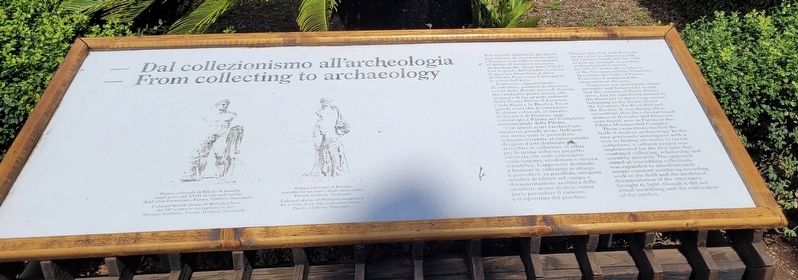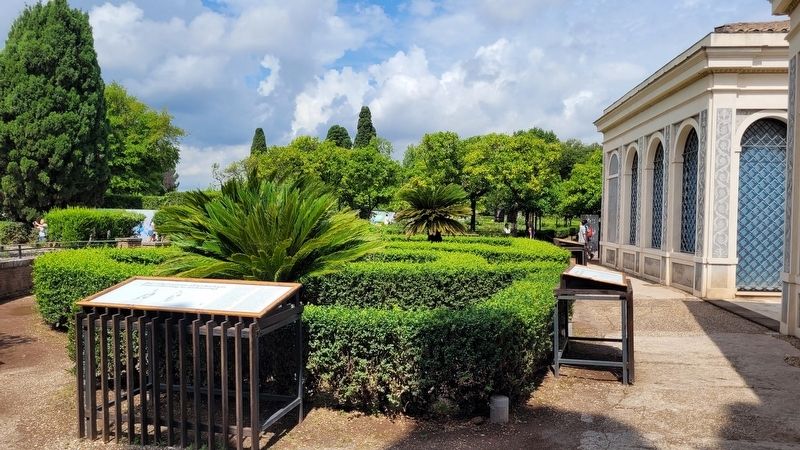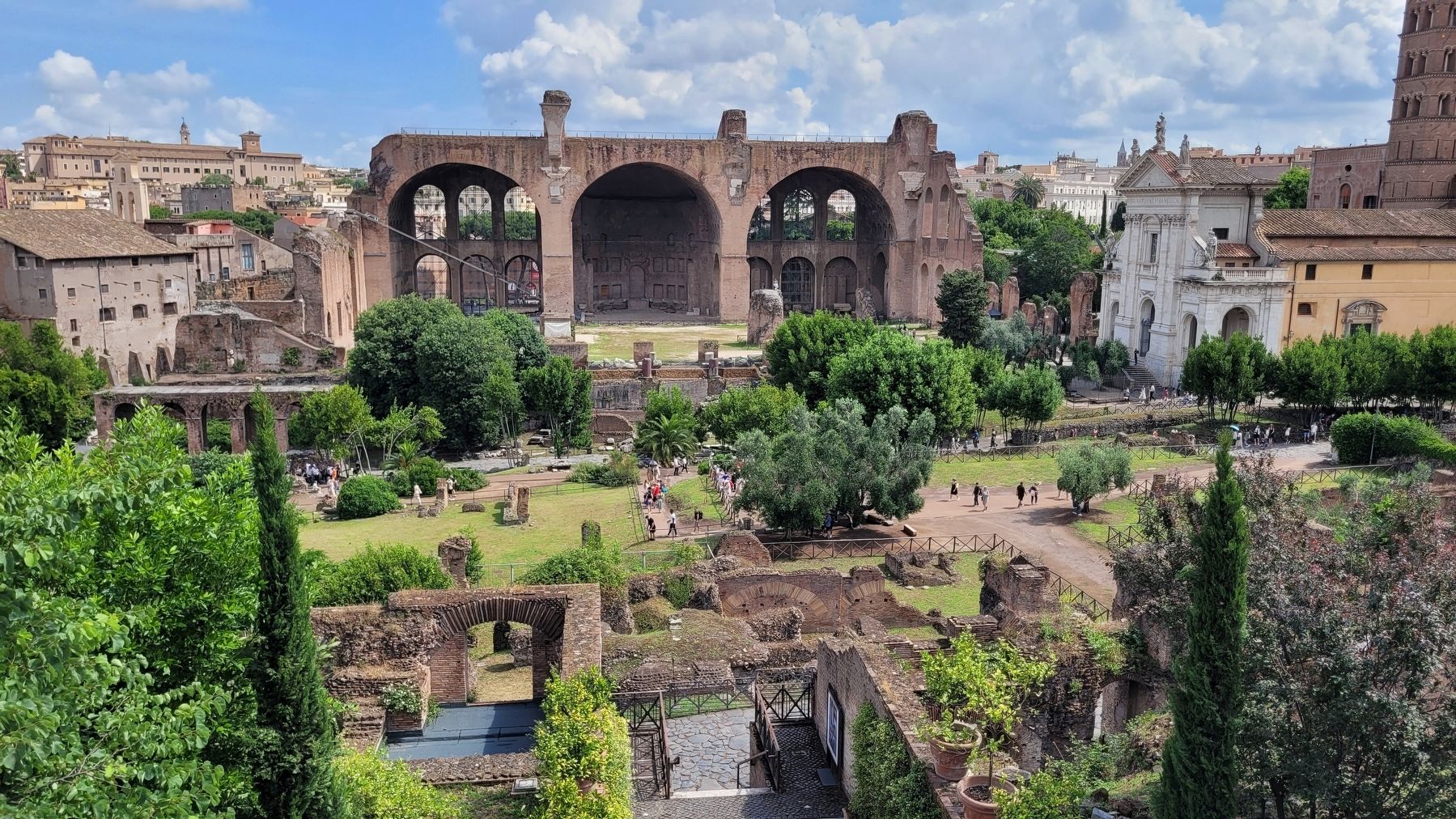Rione X Campitelli in Roma in Città metropolitana di Roma Capitale, Latium, Rome, Italy — Central Italy (Tyrrhenian Coast)
Dal collezionismo all'archeologia / From collecting to archaeology
Inscription.
Francesco, appassionato di antichità, pensava di ritrovare i resti della Domus Aurea di Nerone, ma l'indagine portò invece alla scoperta di tre grandi ambienti della Domus Flavia: il Lararium, l'Aula Regia e la Basilica. Fu in questi scavi che si rinvennero le statue colossali, in basalto, di Ercole e di Dioniso, oggi conservate a Parma nel Complesso monumentale della Pilotta.
Con questi scavi l'archeologia moderna prende avvio. Nell'area che aveva visto le precedenti indagini orientate al ritrovamento di opere d'arte destinate ad arricchire le collezioni, si attua per la prima volta un progetto culturale che vede convergere collezionismo, erudizione e ricerca scientifica. L'approccio destinato a formare le collezioni si allarga a prevedere, in parallelo, un'opera assidua di rilievo sul campo e documentazione analitica delle strutture messe in luce, senza però, prevedere il rinterro e il ripristino del giardino.
Didascalie
Statua colossale di Ercole in basalto dagli scavi del XVIII secolo nell'ambito degli Orti Farnesiani, Parma, Galleria Nazionale
Statua colossale di Dioniso soretto da un satiro dagli stessi scavi, Parma, Galleria Nazionale
Though they had rented out the estate to try to obtain a profit, the Farnese family did not wish to give up the right to conduct archaeological research. In 1721-27, under the guidance of the Veronese scholar Francesco Bianchini, the Duke of Parma Francesco I undertook the excavation of the area.
Francesco was passionate about antiquity and believed he would find the remains of Nero's Domus Aurea, but his search led instead to the discovery of three large rooms belonging to the Domus Flavia: the Lararium, the Royal Hall and the Basilica. It was during these excavations that the colossal basalt statues of Hercules and Dionysus were found, now in Parma in the Pilotta Monumental Complex.
These excavations marked the birth of modern archaeology. In the area previously investigated with a view to finding art works to enrich collections, a cultural project was implemented for the first time that combined collecting,
scholarship and scientific research. The approach aimed at assembling collections was expanded to simultaneously ensure constant assiduous recording work in the field and the analytical documentation of the structures brought to light, though it did not entail backfilling and the restoration of the garden.
Captions
Colossal basalt statue of Hercules from the 18th-century excavations in the Farnese Gardens, Parma, Galleria Nazionale
Colossal statue of Dionysus supported by a satyr from the same excavations, Parma, Galleria Nazionale
Topics. This historical marker is listed in these topic lists: Anthropology & Archaeology • Architecture. A significant historical year for this entry is 1721.
Location. 41° 53.415′ N, 12° 29.235′ E. Marker is in Roma, Lazio (Latium, Rome), in Città metropolitana di Roma Capitale. It is in Rione X Campitelli. Marker is at the intersection of Via Sacra and Via Nova on Via Sacra. The marker is located west of the Arch of Titus in the Roman Forum. Touch for map. Marker is in this post office area: Roma, Lazio 00186, Italy. Touch for directions.
Other nearby markers. At least 8 other markers are within walking distance of this marker. Le ragioni dell'archeologia / The development of archaeology (here, next to this marker); Con gli occhi di Goethe / With the eyes of Goethe (here, next to this marker); Palatino: Il Giardino dei Farnese / The Palatin Hills: the Farnese Garden
(a few steps from this marker); Giacomo Boni sul Palatino / Giacomo Boni on the Palatine (a few steps from this marker); I giardini del XIX secolo / The gardens of the 19th century (a few steps from this marker); Il restauro / The conservation project (a few steps from this marker); Teatro del Fontanone / Fountain Theater (a few steps from this marker); Uccelliere / Aviary (a few steps from this marker). Touch for a list and map of all markers in Roma.
More about this marker. The marker is located in the Parco Archeologico del Colosseo (Roman Forum Archaeological Park) and it does require an entry fee to visit.
Also see . . .
1. Parco Archeologico del Colosseo. Roma Turismo (Submitted on August 8, 2023, by James Hulse of Medina, Texas.)
2. Francesco Bianchini. Wikipedia
Francesco Bianchini (13 December 1662 – 2 March 1729) was an Italian philosopher and scientist. He worked for the curia of three popes, including being camiere d'honore of Clement XI, and secretary of the commission for the reform of the calendar, working on the method to calculate the astronomically correct date for Easter in a given year.(Submitted on August 8, 2023, by James Hulse of Medina, Texas.)
Credits. This page was last revised on August 8, 2023. It was originally submitted on August 7, 2023, by James Hulse of Medina, Texas. This page has been viewed 45 times since then and 6 times this year. Photos: 1, 2, 3. submitted on August 8, 2023, by James Hulse of Medina, Texas.


